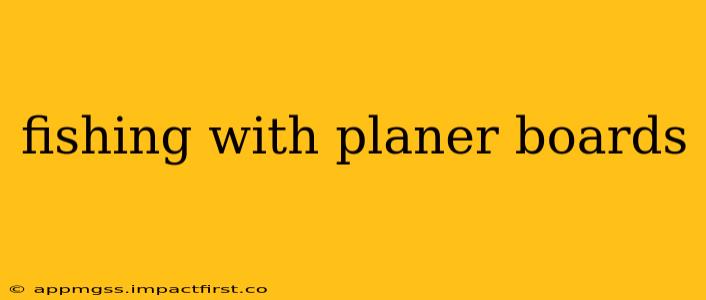Fishing with planer boards is a highly effective technique for covering vast amounts of water and enticing fish to strike. This method allows anglers to troll multiple lines at different depths and distances from the boat, significantly increasing their chances of success. Whether you're targeting trout, salmon, walleye, or muskie, understanding how to effectively utilize planer boards can dramatically improve your fishing experience. This guide will delve into the intricacies of planer board fishing, answering common questions and providing expert tips to maximize your catch.
What are Planer Boards and How Do They Work?
Planer boards are essentially small, flat boards that are attached to your fishing line via a release clip. They're deployed off the side of your boat, and as you troll, the board's design creates resistance in the water, pulling your lure away from the boat and into the "strike zone" where fish are likely to be feeding. This allows you to effectively cover more water and present your bait to a wider range of fish. The key is that they deploy your lures beyond the boat's wake, into undisturbed water. Many models feature adjustable settings to control the depth and distance the lure is deployed.
What are the Benefits of Using Planer Boards?
The advantages of using planer boards are numerous:
- Increased Coverage: They allow you to cover significantly more water than trolling with lines directly behind the boat.
- Presentation: Planer boards present your lures naturally, mimicking baitfish behavior in a more realistic manner.
- Depth Control: Many boards allow for adjustments to control the depth at which your lure runs.
- Multiple Lines: You can run multiple lines simultaneously, greatly increasing your chances of a strike.
- Avoiding Tangled Lines: Planer boards help keep your lines separated, reducing the risk of tangles.
How to Set Up Planer Boards for Fishing?
Setting up planer boards involves several steps:
- Choose the Right Board: Select a planer board appropriate for your boat size and target species.
- Attach the Release Clip: Securely attach a release clip to the planer board.
- Attach the Line: Connect your fishing line to the release clip.
- Attach the Lure: Use a lure appropriate for your target species and fishing conditions.
- Deploy the Boards: Carefully deploy the planer boards from the sides of your boat, allowing sufficient line to extend beyond the board.
- Adjust the Settings: Adjust the planer board's settings to control the depth and distance of your lure.
- Maintain Tension: Maintain appropriate tension on the lines to ensure proper board function.
What Type of Line is Best for Planer Board Fishing?
The best type of line for planer board fishing is typically braided line. Braided line is exceptionally strong for its diameter, providing excellent sensitivity and allowing for longer casts. Its lack of stretch also helps in detecting subtle strikes. However, many anglers use mono or fluorocarbon leader material tied to the braid to increase the lure's action and subtlety.
What Kind of Lures Work Best with Planer Boards?
The best lures for planer board fishing vary depending on the target species and water conditions. However, some popular choices include:
- Crankbaits: Effective for a variety of species.
- Spoons: Excellent for attracting fish with their flashy action.
- In-line spinners: Another classic choice that works across many species.
How Far Apart Should Planer Boards Be?
The optimal distance between planer boards depends on several factors, including the width of your boat and the length of your lines. Generally, it's recommended to keep them spaced a minimum of 15-20 feet apart to avoid tangles.
What are the Common Mistakes to Avoid When Using Planer Boards?
- Using Too Much Line: Over-deploying lines can lead to tangles and reduced control.
- Incorrect Board Setting: Improperly adjusted planer boards can limit the effectiveness of your trolling strategy.
- Neglecting Line Maintenance: Regularly inspect and maintain your lines to prevent breakages.
- Ignoring Water Conditions: Adapt your technique to account for changing water conditions.
By understanding these principles and avoiding common pitfalls, you can significantly improve your success rate with planer boards and enjoy a more rewarding fishing experience. Remember, practice and experimentation are key to mastering this versatile technique.
